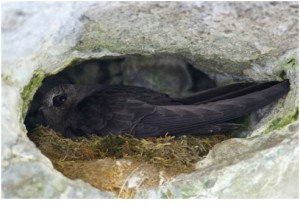
Parks Canada’s recent approval of hang gliding and paragliding in Jasper National Park is raising concerns among birdwatchers and environmentalists about the impact these new activities could have on the park’s birds.
In recent weeks, the elusive black swift, which nests in Maligne Canyon, was recently assessed as “endangered” by the Committee on the Status of Endangered Wildlife in Canada (COSEWIC).
With only about 10 birds left at Maligne Canyon, Volker Schelhas, a birdwatcher who has been keeping an eye on the population since 1986, said he is concerned that Parks didn’t specifically mentioned Maligne Canyon as an environmentally sensitive site within its guidelines for paragliding and hang gliding in the park.
“It would be of utmost importance that Parks Canada include the Maligne Canyon area as a no-fly zone and especially doesn’t allow launches, because launches would go right over the area the black swifts use as they approach their nests,” said Schelhas.
Last week, Parks formally allowed hang gliding and paragliding flights to launch and land at undesignated sites throughout Jasper National Park as part of a two-year pilot project. The agency restricted the activities in environmentally sensitive sites such as, Jasper House and the Maligne Lake outlet, as well as waterways in the park.
“Take offs, landings and low level flying are prohibited within 30 metres of all watercourses, including the Maligne River which flows through the Maligne Canyon,” wrote Amber Stewart, integrated land use planner for Jasper National Park, in an email. “Parks Canada is confident that the mitigations put in place as part of the guidelines for new recreational activities for Jasper National Park are sufficient to address the potential environmental impacts of this activity, including to park bird populations.”
In the guidelines, Parks also forbids flights in the Jasper townsite, the Marmot Basin ski area or within 1,000 metres of active raptor nests or mineral licks.
While human activity is of some concern, Jon McCraken, the director of national programs for Birds Studies Canada, said there isn’t enough information to pinpoint the cause of the black swift’s rapid decline.
“Since 1970 we’ve seen a decline of at least 50 per cent, but probably closer to 70 or 80 per cent, so it’s an extremely worrisome situation,” he said.
“It’s a little bit troubling, but we have no idea whether paragliding or anything else is going to impact black swifts one way or another, we really don’t know.”
Part of the problem is scientists don’t have enough data about the elusive birds, but they suspect the bird’s food supply might be a major cause in their decline. Black swifts subsist on insects.
“We suspect something is going on with the food supply, whether it’s here on the breeding grounds in Canada or the wintering grounds in South America or parts in between, we just don’t know,” said McCraken.
“There needs to be a huge research effort just to uncover more about what’s happening on the wintering grounds and during migration, because the problems may occur here in Canada or may be somewhere else, but until you get a handle about what the real threats are it’s impossible to recover a population.”
Currently there are thought to be between 15,000 to 60,000 adult black swifts in Canada, which is home to about 80 per cent of the world’s population. In Alberta there are only about two-dozen birds left.
In the late 1980s there were about 20 birds at Maligne Canyon, according to Schelhas. That number now hovers between 10 to 12 birds.
“I’ve seen a decline here and there’s been an even more serious decline at the other nesting colony in Banff National Park in Johnston’s Canyon. There they have declined a lot more, I think last year there was only one pair left,” he said.
The Jasper Environmental Association (JEA) also voiced its concern about the impact the new activities could have on the park’s wildlife.
“Parks funding has been cut so badly, they just can’t afford to do these kinds of things any more,” said Jill Seaton, chair of the JEA, about the agency’s ability to do research.
She said the entire plan appears to have been developed in Ottawa and ignores Parks’ legislative mandate.
“This was definitely hatched in Ottawa and now Parks, as usual, is forced to agree with the government and make it look like it fits in with their legislative mandate, which it doesn’t, because their legislative mandate is to protect the wilderness and wildlife.”
Seaton acknowledged the restrictions set out in the guidelines, but said the term “raptor” is too vague a term and doesn’t refer to other endangered birds, such as the black swift, that don’t eat animals.
The black swift was one of 20 species recently assessed as a species at risk across Canada by COSEWIC.
“If the conditions don’t change fairly soon, we think the species is in imminent danger of extinction or extirpation,” said Eric Taylor, co-chair of COSEWIC, during an interview from southern France.
The committee, which meets twice a year, is an arms length agency that provides the federal government with status assessments based on scientific, community and aboriginal knowledge.
Four of the species recently assessed as at-risk are found in southern Alberta—including the vivid dancer damselfly, the prairie rattlesnake, the yellow-banded bumble bee and the black swift.
Black swifts are black in colour with slightly lighter under-wings and often build nests behind waterfalls or on damp cliffs. They tend to spend the majority of their time high in the air, flying extremely quickly.
They only lay one egg a year and are considered a slow to mature species.
In the winter they migrate vast distances in order to forage on insects, which require warmer weather.
“It’s a really sad comment on the state of our birds in general, that more and more birds have to be declared endangered,” said Schelhas.
Paul Clarke
[email protected]
